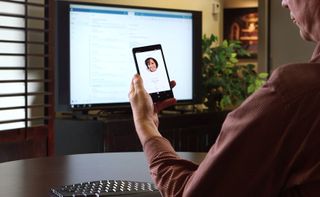Continuum on Windows Phone is about emerging markets and meeting future computing needs

Microsoft head honcho Satya Nadella had a neat little appearance at the Salesforce Dreamforce conference and with it a demonstration of what Microsoft is working on these days.
Microsoft's Continuum for Windows Phone – the idea of running your phone as a mini-PC – is certainly one of the differentiating features of the Windows 10 Mobile OS. Indeed, it is not clear just how Apple or Google could respond to such technology.
Nadella gave a quick demonstration of the forthcoming feature. Perhaps the biggest news is the confirmation that Continuum can run just fine over Bluetooth connections. Users, however, can opt to choose the unannounced Continuum dock (codenamed 'Munchkin') to connect their phone physically as well. That dock is expected to retail for $99, and it should be announced in October at Microsoft's New York City press event.
Continuum and the long term plan fo emerging markets
Continuum is much like HoloLens in that we won't see the fruits of its labor for some time. While those in enterprise could certainly benefit from the technology, it is emerging markets where it will ultimately have the biggest impact. The reason? For many their smartphone is the first – and only – computing device. The question next is how to you make it more meaningful? One way is to make the phone more significant is through Continuum by letting them use any display to re-create a near full PC experience.
What to expect from Microsoft's Windows 10 devices event in NYC
Meet the newly announced Jade Primo, Acer's first PC smartphone with Continuum {.cta}
However, like all new technology, it starts in the upper price tiers, and it has to trickle down to more affordable phones. Hence the long term plan of Continuum. For now, it is limited to Microsoft's high-end phones, but in a just a few short years, their budget line will feature it as well.
Get the Windows Central Newsletter
All the latest news, reviews, and guides for Windows and Xbox diehards.
Do think the continued blurring of tablets, PCs, and phones is where technology is heading? Is Microsoft actually ahead of the curve? Let us know your thoughts in comments.

Daniel Rubino is the Editor-in-chief of Windows Central. He is also the head reviewer, podcast co-host, and analyst. He has been covering Microsoft since 2007, when this site was called WMExperts (and later Windows Phone Central). His interests include Windows, laptops, next-gen computing, and watches. He has been reviewing laptops since 2015 and is particularly fond of 2-in-1 convertibles, ARM processors, new form factors, and thin-and-light PCs. Before all this tech stuff, he worked on a Ph.D. in linguistics, watched people sleep (for medical purposes!), and ran the projectors at movie theaters because it was fun.
